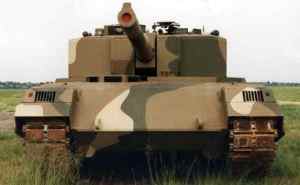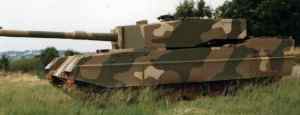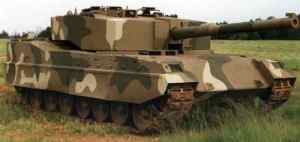| Designation: | TTD |
 |
|---|---|---|
| Manufacturer: | Armaments Corporation of South Africa Ltd (ARMSCOR) | |
| Product type: | Armoured Vehicles | |
| Name: | Main battle tank |
The TTD programme originated from the need to replace the Olifant (upgraded British Centurion) MBT that is currently in service with South Africa with a new MBT that would then have served the army well into the 21st century.
The army does not currently have the funding to bring a new MBT into production, but will support the programme as a technology demonstrator. Some of the subsystems of the TTD will be applied to upgrading the current Olifant MBT (qv) and the Rooikat (8 x 8) armoured car (qv), as well as being offered for export.
Others are still in development and include a GPS-aided vehicle navigation/command and control system and a near vertical incidence skywave communications system.
The TTD (development code name of the vehicle was Loggim) was developed from 1983 on the basis of the army's very extensive operational experience in the harsh bush environment of northern Namibia and southern Angola. The opposing tank was assumed to be the 125 mm armed Russian T-72 and its successor.
Core design considerations included the ability to operate a long way from any workshop support, the need to self-deploy over long distances when transporters are not available, and suiting the tank to being both operated and maintained by conscripts and reservists.
ARMSCOR is the overall director of the TTD programme with LIW, a division of Denel, being responsible for the complete turret and armament and Reunert Defence OMC responsible for the complete chassis.
Other companies involved in the TTD include Kentron, Eloptro, M-Tek, Grinel, IST, Teglogic, Booyco and PDS.
The layout of the TTD is conventional, with the driver being seated at the front right, the turret in the centre and the power pack at the rear.
No details of the protection of the TTD have been released except that it comprises multiple spaced armour components with the frontal arc being protected against APFSDS and HEAT rounds of an unspecified calibre. The TTD has all-round protection against some medium-calibre fire and all small arms fire.
All critical subsystems are protected against medium-calibre fire with protection against certain types of anti-tank mine also being incorporated. The basic hull and turret are of all-welded steel armour construction.
Provision has also been made for alternative main armour modules and for the installation of explosive reactive armour to protect the frontal arc.
The commander is seated on the right of the turret with the gunner forward and below the commander and the loader on the left of the turret. Both commander and loader are provided with roof hatches.
Main armament is currently the same 105 mm L7 (which in current production form is known as the GT 3 in South Africa) rifled gun as mounted in the Olifant MBT but fitted with an improved breech. The barrel has a thermal shield and a muzzle reference system. The turret has been designed to mount LIW's GT6 120 mm smoothbore gun. This gun, in turn, has been designed to allow later fitting of an LIW 140 mm barrel when the threat demands.
Mounted coaxially with the 105 mm gun is a 7.62 mm machine gun and a 7.62 mm machine gun can be mounted on the turret roof for local and anti-aircraft defence.
A bank of four electrically operated smoke grenade launchers is mounted either side of the turret under full armour protection; these fire to the front and sides of the vehicle. In addition, the TTD can lay its own smoke screen by injecting diesel fuel into the exhaust outlet.
If required, a roof-mounted laser detector can be fitted on the TTD.
The TTD carries a total of 54 rounds of 105 mm ammunition: six ready rounds in the turret basket, 16 APFSDS rounds in the turret bustle magazine with automatic feed to the loader through a loading port, and 32 rounds to the left of the driver in the front of the hull. The coaxial 7.62 mm machine gun is fed from a 2,000-round bin but it can also be fed from standard 200-round boxes.
The fully integrated digital fire direction system (FDS) is claimed to give excellent first and second round hit probabilities and a rate of fire of 6 rds/min. It has been designed as a modular system, allowing it to be matched to the user's requirements and later upgraded as a developing situation may demand.
In the version fitted to the TTD, the FDS has primarily stabilised day/night sights for both the commander and gunner. The gunner's x8 magnification sight (GS60) incorporates an integrated laser rangefinder and a 120-element thermal imager night channel. The 360º panoramic commander's sight (CS60N) has x3 and x10 magnification and is fitted with a third-generation image-intensifier night channel.
The commander and gunner are both provided with a monitor for the thermal imaging system.
In its operational mode the gun can be slaved to the gunner's or the commander's sight. Coincidence logic ensures that required accuracies and reaction times are achieved while firing on the move.
The commander has full override capability, allowing him to pass targets to the gunner or engage emergency targets himself. The digital computer takes into account the ammunition type, the turret and weapon dynamics and the data from the environmental sensors and the muzzle reference system.
The turret and gun are driven by new compact 48 V electric turret and gun drives using brushless motors. They give a smooth tracking capability, reducing the demands on the stabilisation system and allowing the best use of the fire-on-the-move capability.
According to Reunert Defence OMC, the first round hit probability of engaging a T-72 MBT target at a range of 2,000 m with APFSDS ammunition is 84 per cent when the target is static and 75 per cent when the target is moving. Effective ammunition ranges with the different types of ammunition are as follows:
APFSDS-T 4,000 m
HEAT 2,000 m
HESH 2,000 m
HE-T 4,500 m
An RS-485 serial databus with a 5 ms update cycle links all the elements of the FDS, allowing both integrated and independent operation of its subsystems. This serves to enhance the overall system application by both gunner and commander and also serves to facilitate fault diagnosis and training.
The turret bustle magazine has blast-off panels and the crew compartment is completely isolated from the bustle, ensuring that the crew will not be harmed in the event of penetration causing ammunition explosion. The danger is further reduced by carrying APFSDS rounds in the bustle magazine, which exposes only propellant to potential danger, not HE warheads.
The TTD is powered by a twin-turbo intercooled V-8 diesel that delivers its maximum power of 1,230 hp at 2,100 rpm and maximum torque at 1,500 rpm which gives the TTD a power-to-weight ratio of 21.1 hp/t with acceleration of 0 to 30 km/h in 5.1 seconds.
An emergency hydraulic starting system is incorporated to start the engine in the event of an electrical power or starter motor failure.
Cooling is provided by a water-to-air system which is split for cooling charge air to the intake manifold. The engine can deliver full power continuously up to an ambient temperature of 48ºC, after which the power pack management system derates the power delivery to protect the engine. The exhaust gases are mixed with cooling air to reduce the infrared signature of the tank.
The engine drives through an automatic gearbox with four forward and two reverse gears. The final drives incorporate a planetary gear reduction with an offset configuration. They are capable of handling a 1,500 hp power pack should additional power be needed later. The steering system allows neutral turns and is infinitely variable for large radius turns and fixed for tighter turns.
The suspension uses a live track running over seven rubber-tyred dual roadwheels with idler at the front, drive sprocket at the rear and four return rollers. The roadwheels are mounted on torsion bars with 500 mm vertical travel (320 mm up, 180 mm down). Wear resistant, maintenance-free hydraulic variable resistance friction dampers and hydraulic bump stops absorb cross-country energy loadings.
The braking system comprises a primary retarder and double disc service brakes integrated into the gearbox. It can bring the TTD to a halt from 56 km/h in 6.8 seconds. The heat built up in the retarder is dissipated through the cooling system.
An automatic explosion suppression system activated by optical detectors is fitted in the turret and the driver's compartments. The engine bay has a fire detection and suppression system and the fuel tanks are fitted with explosafe.
The TTD has seals to provide overpressure BC protection and its environmental control system has been designed to incorporate full BC should there be a requirement for this. In addition, the design provides for individual crew member BC protection should this be required by the user.
|
||||||||||||||||||||||||||||||||||||||||||||||||||||
 |
 |
 |
